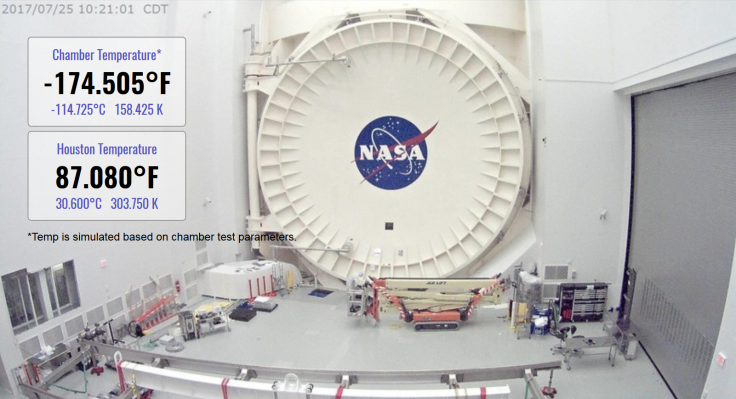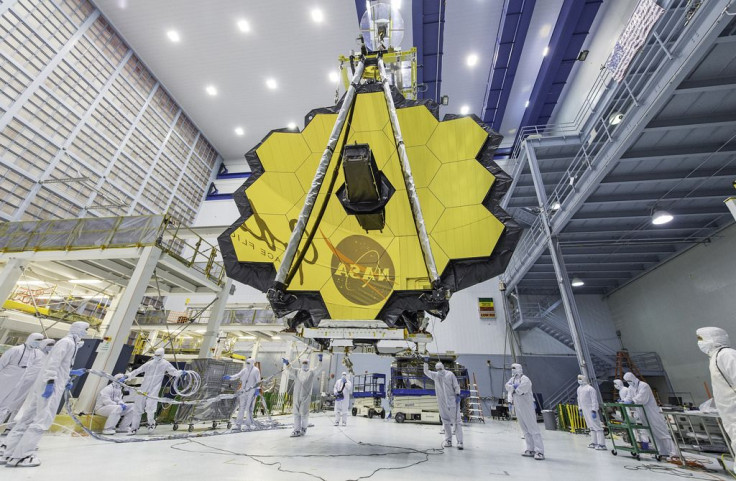Watch NASA Deep Freeze Its Alien-Hunting Telescope In Test

NASA is putting its new telescope into a deep freeze to test how it will operate in outer space, and it is broadcasting the cold experiment online.
The James Webb Space Telescope was built and recently moved to the Johnson Space Center in Houston, where it was put into a temperature chamber. Although the telescope is not visible while it is locked inside, a stream of the chamber’s exterior from its “Webbcam” includes a comparison between the temperature in that area compared to the temperature outside in the heat of Texas. While Houston was hitting the mid-90s on Wednesday, the NASA chamber was at -250 degrees Fahrenheit.
Read: Now You Can Watch Historic NASA Footage
“The temperature of the Chamber A will continue to steadily drop until it reaches about 20 kelvins (minus 424 degrees Fahrenheit/minus 253 degrees Celsius),” NASA’s Goddard Space Flight Center explained, “but it will take a little while longer for the Webb telescope and its instruments to reach the same temperatures they will be when operating in space.”
During the course of the experiment, which will last about 100 days, eventually the instruments will get to about -393 degrees Fahrenheit, their operating temperature. That’s with the exception of one instrument: the mid-infrared instrument, which contains a camera and observes light in the mid-infrared range.
According to NASA Goddard, that instrument has to be even colder than the others, reached -447 degrees Fahrenheit. To do that, it will use its own special cooling system.

The telescope has to be able to withstand the cold temperatures of space when it ventures 1 million miles out, but it would need to be cold even if space was hot: “In space, the telescope must be kept extremely cold in order to be able to detect the infrared light from very faint, distant objects,” NASA says.
In order to prevent the telescope from the light and heat of the sun, as well as anything coming from the Earth and the moon, Webb has a shield that works like a parasol to keep it shaded. NASA describes it as being composed of five layers and the size of a tennis court.
.@NASAWebb has the capacity to detect the heat of a bumblebee if it were on the moon. #FollowFriday to learn more: https://t.co/C2oXKvqLFJ pic.twitter.com/ZKeKTxhyMh
“The sunshield blocks sunlight from interfering with the sensitive telescope instruments,” according to NASA. “The sunshield separates the observatory into a warm, sun-facing side (reaching temperatures close to 185 degrees Fahrenheit/85 degrees Celsius) and a cold side (minus 400 degrees Fahrenheit/minus 240 degrees Celsius).”
Once it is launched in late 2018, the Webb space telescope will be searching for potentially habitable planets outside our solar system, among other focuses. One of the alien solar systems it will investigate is the Trappist-1 system, where seven rocky planets orbit a small star and at least three of them might be within the star’s habitable zone — the distance from the planet that is just the right temperature to support liquid water, one of the requirements to sustain life.
Read: NASA Spacecraft Sees Lots of Huge Comets in Our Solar System
“If these planets have atmospheres, the James Webb Space Telescope will be the key to unlocking their secrets,” NASA exoplanet program scientist Doug Hudgins previously said.
The telescope will learn more about their atmospheres, including their water content and how much oxygen, carbon dioxide and other gases make them up.
Webb is being tested at a time when astronomers are constantly finding more exoplanets in the wider solar system, giving people hope that at least one of them contains extraterrestrial life.
The telescope has been a hit with the public, inspiring artists to create paintings, tattoos and works of art in various other media — which NASA is accepting and sharing.
© Copyright IBTimes 2024. All rights reserved.




















